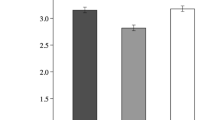Abstract
We present and test empirically a new theory of property and contract rights. Any incentive an autocrat has to respect such rights comes from his interest in future tax collections and national income and increases with his planning horizon. We find a compelling empirical relationship between property and contract rights and an autocrat's time in power. In lasting—but not in new—democracies, the same rule of law and individual rights that ensure continued free elections entail extensive property and contract rights. We show that the age of a democratic system is strongly correlated with property and contract rights.
Similar content being viewed by others
References
Abraham, Katharine G., and Henry S. Farber. (1987). “Job Duration, Seniority, and Earnings.” American Economic Review 77, 278–297.
Abrams, Burton A., and Kenneth A. Lewis.(1993). “Cultural and Institutional Determinants of Economic Growth:A Cross-Section Analysis.” Paper presented at the 1993 Public Choice annual meetings, New Orleans.
Alesina, Alberto, Sule Ozler, Nouriel Roubini, and Philip Swagel. (1996). “Political Instability and EconomicGrowth.” Journal of Economic Growth 1, 193–215.
Banks, Arthur S. (1979). “Cross-National Time Series Data Archive.” Center for Social Analysis, State Universityof New York at Binghamton (updated).
Barro, Robert. (1996). “Democracy and Growth.” Journal of Economic Growth 1, 1–27.
Bhalla, Surjit. (1994). “Freedom and Economic Growth: A Virtuous Circle?” Paper presented at Nobel Sympo-sium on “Democracy's Victory and Crisis,” Uppsala University, Sweden, August 27–30.
Bienen, Henry, and Nicolas van de Walle. (1991). Of Time and Power: Leadership Duration in the ModernWorld. Stanford: Stanford University Press.
Bollen, Kenneth A. (1990). “Political Democracy: Conceptual and Measurement Traps.” Studies in ComparativeInternational Development 45, 7–24.
Brunetti, Aymo, and Beatrice Weder. (1993). “Political Sources of Growth: The Need for New Measurement.” WWZ Discussion Paper 9313, University of Basel, Basel, Switzerland.
Burkhart, Ross, and Michael Lewis-Beck. (1994). “Comparative Democracy: The Economic DevelopmentThesis.” American Political Science Review 88, 903–910.
Clague, Christopher. (1993). “Rule Obedience, Organizational Loyalty, and Economic Development.” Journalof Institutional and Theoretical Economics 149, 393–414.
Clague, Christopher, Philip Keefer, Stephen Knack, and Mancur Olson. (1995). “Contract-Intensive Money.” IRIS Working Paper 151, February.
de Long, J. Bradford, and Andre Schleifer. (1993). “Princes and Merchants: European City Growth Before theIndustrial Revolution.” Journal of Law and Economics 36, 671–702.
Eggertsson, Thrain. (1990). Economic Behavior and Institutions. Cambridge: Cambridge University Press.
Gastil, Raymond D. (1989). Freedom in the World. New York: Freedom House.
Grossman, Herschel I., and Suk Jae Noh. (1990). “A Theory of Kleptocracy with Probabilistic Survival andReputation.” Economics and Politics 2, 157–171.
Gurr, Ted Robert. (1990). Polity II: Political Structures and Regime Change, 1800–1986. First ICPSR Edition, Inter-University Consortium for Political and Social Research, P.O. Box 1248 Ann Arbor, Michigan.
Helliwell, John. (1994). “Empirical Linkages Between Democracy and Growth.” British Journal of PoliticalScience 24, 225–248.
Keefer, Philip, and Stephen Knack. (1995). “Inequality, Property Rights, and Growth.” Paper presented at the American Economic Association annual meetings in Washington DC, January. IRIS Working Paper no. 153.
Knack, Stephen, and Philip Keefer. (1995). “Institutions and Economic Performance: Cross-Country Tests Using Alternative Institutional Measures.” Economics and Politics 7, 207–227.
Lichbach, Mark Irving. (1995). The Rebel's Dilemma. Ann Arbor: University of Michigan Press.
Lipset, Seymour Martin. (1959). “Some Social Requisites of Democracy: Economic Development and PoliticalLegitimacy.” American Political Science Review. 53, 69–105.
Londregan, John, and Keith T. Poole. (1991). “The Seizure of Executive Power and Economic Growth: Some Additional Evidence.” Unpublished manuscript.
Madison, James. (1983). The Papers of James Madison. Edited by Robert A. Rutland, Thomas A. Mason, Robert J. Brugger, Jeanne K. Sisson, and Fredrika J. Teute. Charlottesville: University Press of Virginia.
McGuire, Martin, and Mancur Olson. (1996). “The Economics of Autocracy and Majority Rule.” Journal of Economic Literature 34, 72–96.
Olson, Mancur. (1965). The Logic of Collective Action. Cambridge: Cambridge University Press.
Olson, Mancur. (1991). “Autocracy, Democracy, and Prosperity.” In Richard J. Zeckhauser (ed.), Strategy and Choice. Cambridge: MIT Press.
Olson, Mancur. (1993). “Dictatorship, Democracy, and Development.” American Political Science Review 87, 567–576.
Persson, Torsten, and Guido Tabellini. (1994). “Is Inequality Harmful for Growth?” American Economic Review 84, 600–621.
Rosenberg, Nathan, and L. E. Birdzell. (1986). How the West Grew Rich: The Economic Transformation of the Industrial World. New York: Basic Books.
Svensson, Jakob. (1994). “Investment, Property Rights, and Political Instability.” Unpublished manuscript, Institute for International Economic Studies, Stockholm University.
White, Hal. (1980). “A Heteroskedasticity-Consistent Covariance Matrix Estimator and a Direct Test for Heteroskedasticity.” Econometrica 48, 817–838.
Author information
Authors and Affiliations
Rights and permissions
About this article
Cite this article
Clague, C., Keefer, P., Knack, S. et al. Property and contract rights in autocracies and democracies. J Econ Growth 1, 243–276 (1996). https://doi.org/10.1007/BF00138864
Issue Date:
DOI: https://doi.org/10.1007/BF00138864




